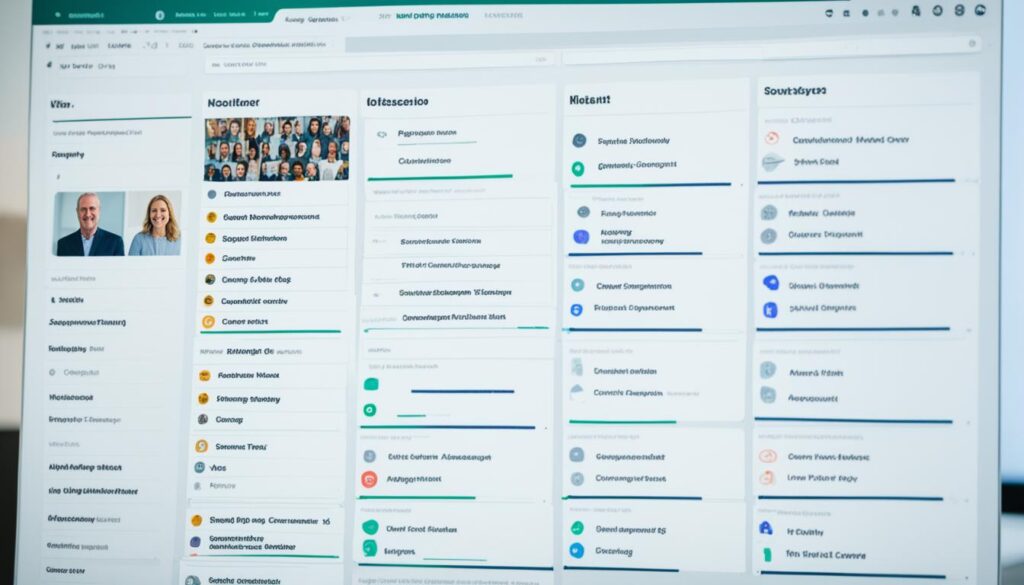Did you realize that effective inbound marketing can greatly enhance the digital presence of small to medium-sized businesses (SMBs)? Research indicates that by implementing successful inbound marketing tactics, SMBs can experience a 120% boost in their customer conversion rates. As the number of ecommerce users continues to rise rapidly, it is essential for SMBs to develop a strong marketing strategy in order to remain competitive and draw in valuable leads.
In this comprehensive guide, we will provide you with tips and strategies specifically designed for SMBs to achieve successful inbound marketing. Whether you’re a small business looking to expand your online reach or a medium-sized company wanting to optimize your existing marketing efforts, this guide will equip you with the knowledge and tools necessary to thrive in the digital landscape.
Key Takeaways:
- Implementing effective inbound marketing can lead to a significant increase in the lead-to-customer conversion rate for SMBs.
- With the predicted growth of ecommerce users, having a robust marketing strategy is crucial for SMBs to attract valuable leads.
- This comprehensive guide will provide tips and strategies specifically tailored for small and medium-sized businesses.
- By following the advice in this guide, SMBs can optimize their marketing efforts and thrive in the digital landscape.
- Inbound marketing is an essential tool for SMBs to stay ahead of the competition and increase their online presence.
Small Business Marketing Strategies
As a small business, marketing can be a challenging endeavor due to limited budgets and resources. However, with the right strategies in place, you can effectively scale your marketing efforts and generate awareness for your organization. In this section, we will explore key marketing strategies that can help you establish a strong presence and attract potential customers.
Knowing Your Audience
One of the fundamental aspects of any successful marketing plan for a small business is understanding your target audience. By knowing who your customers are, their needs, and their preferences, you can create tailored marketing campaigns that resonate with them. Conduct market research, analyze customer data, and engage with your audience to gain insights that will guide your marketing efforts.
Emphasizing Your Value Proposition
In a competitive market, it is crucial to differentiate your small business from others. Highlighting your unique value proposition sets you apart and attracts customers. Clearly communicate what sets your business apart, whether it’s exceptional customer service, high-quality products, or innovative solutions. This will help you build a loyal customer base and generate awareness for your organization.
Setting Singular Goals and Objectives
A well-defined marketing plan requires clear goals and objectives. Instead of trying to achieve multiple objectives simultaneously, focus on singular goals that align with your overall business objectives. Whether it’s increasing website traffic, generating leads, or boosting sales, setting specific and measurable goals will help you track your progress and optimize your marketing efforts accordingly.
Capitalizing on Short-Term Plays
Small businesses often have limited budgets and need to make the most out of their marketing efforts. Consider capitalizing on short-term plays that can deliver quick results and drive immediate business. This could involve running limited-time promotions, offering exclusive deals to attract customers, or partnering with other local businesses for joint marketing initiatives.
Doubling Down on What Works
Effective marketing is all about learning from experience and optimizing your strategies based on what works best for your small business. Continually analyze your marketing efforts and identify the channels, campaigns, and tactics that yield the best results. Once you identify what is working, focus your resources on doubling down on these successful marketing initiatives to maximize your impact.
Utilizing Existing Customers as a Powerful Marketing Tool
Your existing customers can be your biggest brand advocates and a valuable source of new business. Encourage satisfied customers to share their positive experiences and refer your business to their friends and family. Implement referral programs and loyalty programs to incentivize repeat business and word-of-mouth marketing. Happy customers can become your most effective marketing agents, helping you generate awareness and attract new customers.
By adopting these small business marketing strategies, you can overcome challenges and make the most out of your marketing efforts. Remember to continually evaluate and adjust your strategies based on real-time data and customer feedback. With a well-executed marketing plan, your small business can successfully generate awareness, attract customers, and achieve long-term success.
Creating a Website for Your SMB
When it comes to small business success in the digital age, having a professional website is essential. It not only establishes your online presence but also serves as a 24/7 salesperson, showcasing your brand, products, and contact information. To attract and convert prospects into leads, it’s crucial for SMBs to invest in a well-designed and user-friendly website.
Why is a website important?
A website acts as a virtual storefront, allowing potential customers to learn about your business, browse your offerings, and contact you easily. With an effective online presence, your SMB gains credibility and is more likely to attract and retain customers.
“A website gives your SMB a professional edge and the opportunity to reach a wider audience. It serves as a digital hub where customers can learn about your brand and make informed purchasing decisions.” – Sarah Thompson, Marketing Consultant
Key considerations for website design
When designing your SMB website, there are several important factors to consider:
- User-friendly navigation: Make sure your website is intuitive and easy to navigate, allowing visitors to find the information they need quickly.
- Mobile responsiveness: With the majority of internet users accessing websites through mobile devices, it’s crucial for your website to adapt and provide a seamless experience on smartphones and tablets.
- Clear call-to-action: Guide visitors towards the desired action, such as making a purchase, subscribing to a newsletter, or filling out a contact form.
- Engaging visuals: Incorporate visually appealing images and videos that align with your brand and capture attention.
- Search engine optimization (SEO): Optimize your website’s content and structure to improve visibility in search engine results and attract organic traffic.
By focusing on these aspects, you can create a website that not only looks great but also delivers a seamless user experience, driving leads and conversions.

Your website as a marketing tool
In addition to being a virtual storefront, your website can serve as a powerful marketing tool. By implementing online marketing strategies such as search engine optimization, content marketing, and social media integration, you can amplify your online presence and reach a wider audience.
With a well-designed website, you can:
- Establish your brand identity and convey your unique value proposition.
- Generate leads through lead capture forms and email subscription options.
- Provide valuable content that educates and engages your audience.
- Optimize your website for search engines to increase organic traffic.
- Integrate social media buttons to encourage visitors to share your content.
A combination of compelling design, user-friendly functionality, and strategic marketing efforts can transform your website into a powerful tool for attracting and converting customers, helping your SMB grow and thrive in the digital landscape.
Blogging and Content Marketing
Attracting prospects to your website and establishing credibility is essential for SMBs. One effective strategy to achieve this is through blogging and content marketing. By creating relevant and valuable content, you can generate organic traffic and engage your audience. Let’s explore how content marketing can help you attract prospects for your website.
Why Content Marketing Matters
Content marketing is more than just creating blog posts. It’s about providing valuable information that solves your audience’s problems and positions your brand as an industry expert. When you consistently produce high-quality content, you build trust with your audience and establish credibility for your SMB.
When prospects find your informative blog posts, they are more likely to stay on your website, explore your other offerings, and eventually become leads. This is because valuable content showcases your expertise and demonstrates that you understand your audience’s needs.
Creating Relevant and Valuable Content
When blogging for your SMB, it’s important to focus on creating content that is relevant to your target audience. Conduct thorough research to understand their pain points, interests, and preferences. This will help you tailor your content to address their specific needs and provide solutions that resonate with them.
Additionally, your content should be valuable and offer real insights or practical tips. This will position you as a reliable source of information and keep your audience coming back for more. By consistently delivering high-quality content, you can build a loyal following of prospects who trust your expertise and are more likely to convert into customers.
Utilizing SEO for Content Optimization
To attract prospects to your website, you need to optimize your content for search engines. Implementing SEO best practices, such as keyword research, meta tags, and internal linking, can help improve your organic search visibility. This means that when prospects search for relevant topics, your blog posts have a higher chance of appearing in the search results.
Remember to use relevant keywords naturally throughout your content, including in headings, subheadings, and within the body. This will help search engines understand the context of your content and rank it higher in the search results, increasing its visibility to potential prospects.

Engaging Your Audience through Calls-to-Action
Content marketing is not just about providing valuable information; it’s also about guiding your audience towards the next step in their customer journey. Including clear, compelling calls-to-action (CTAs) within your blog posts can help drive conversions and generate leads.
CTAs can be used to encourage readers to sign up for your email newsletter, download a gated resource, request a demo, or make a purchase. By strategically placing CTAs throughout your blog posts, you can direct qualified prospects toward actions that move them further down the sales funnel.
Measuring and Analyzing your Content Performance
To ensure the success of your content marketing efforts, it’s important to measure and analyze your content performance. Monitoring metrics such as page views, time on page, bounce rate, and conversion rate can provide valuable insights into how your content is resonating with your audience.
Use Google Analytics or other tracking tools to understand which blog posts are performing well and driving the desired actions. This information can help you refine your content strategy and create more targeted content that attracts and converts prospects.
| Benefits of Blogging and Content Marketing | Techniques for Effective Content Marketing |
|---|---|
| Increases organic traffic to your website | Define your target audience and create buyer personas |
| Establishes credibility and thought leadership | Conduct keyword research to optimize blog content |
| Generates leads and nurtures prospects | Create valuable and engaging content that solves problems |
| Builds brand visibility and awareness | Utilize SEO best practices for content optimization |
| Drives conversions and sales | Include compelling calls-to-action in your blog posts |
Leveraging Social Media
Social media has become an integral part of our daily lives, and it is also a powerful tool for SMBs to reach potential customers, build brand awareness, and promote their products or services. With billions of users on various platforms, social media offers a tremendous opportunity to target and engage with your audience.
One of the biggest advantages of social media marketing for SMBs is the ability to create and share valuable content. By providing valuable information, tips, and insights through your social media channels, you can attract and engage potential customers. Whether it’s sharing blog posts, videos, or infographics, social media allows you to showcase your expertise and build credibility in your industry.
Moreover, social media provides a platform for two-way communication, allowing SMBs to directly engage with their audience. Responding to comments, answering questions, and participating in discussions on social media can help you establish a personal connection with your potential customers, further enhancing their trust and loyalty.
“Social media marketing is a cost-effective way for SMBs to reach a wider audience and connect with potential customers on a more personal level.”
Additionally, social media platforms offer targeted advertising options that can help you reach your ideal audience. With advanced targeting features such as demographics, interests, and behaviors, SMBs can ensure that their ads are displayed to the most relevant users, increasing the chances of conversion.
Furthermore, social media allows SMBs to keep up with industry trends, monitor competitors, and gain valuable insights into their target market. By following industry influencers, engaging with popular trends, and monitoring conversations related to your industry, you can stay ahead of the curve and adapt your marketing strategies accordingly.
Promote SMB on Social Media: Tips and Best Practices
- Create a social media content strategy that aligns with your overall marketing goals and target audience.
- Consistently post valuable and engaging content that resonates with your audience.
- Utilize visuals such as images, videos, and infographics to make your social media posts more engaging and shareable.
- Engage with your audience by responding to comments, messages, and mentions promptly.
- Run targeted advertising campaigns to reach a wider audience and drive traffic to your website or landing pages.
- Monitor social media analytics to track the performance of your campaigns, identify trends, and make data-driven decisions.
By leveraging social media effectively, SMBs can not only engage with potential customers but also build brand awareness and promote their products or services. Social media marketing for SMBs opens up a world of opportunities, allowing you to connect with your audience, establish your brand, and drive business growth.

Influencer Marketing and Brand Awareness
Collaborating with influencers is a powerful SMB marketing strategy that can significantly increase brand awareness. Influencers possess expertise in their niche and have a strong ability to effectively communicate a brand’s story to the right audience. By partnering with influencers, SMBs can expand their reach, gain credibility, and attract new customers.
Why Choose Influencer Marketing?
Influencer marketing offers several benefits for SMBs:
- Expanded reach: Influencers have a dedicated and engaged following, allowing SMBs to reach a wider audience.
- Enhanced credibility: By collaborating with influencers in their industry, SMBs can establish trust and credibility with their target audience.
- Affordable marketing: Working with influencers can be a cost-effective way for SMBs to promote their brand compared to traditional marketing channels.
- Increased engagement: Influencers have a captivating presence and can create engaging content that resonates with their audience, sparking meaningful interactions with SMBs’ brands.
Collaborating with Influencers
When collaborating with influencers, SMBs should consider the following strategies:
- Research and select the right influencers: Identify influencers who have a genuine interest in your niche and align with your brand’s values.
- Establish clear goals and objectives: Define what you aim to achieve through influencer collaborations, whether it’s increasing brand awareness or driving sales.
- Develop a mutually beneficial partnership: Offer value to influencers in return for their support, such as providing exclusive discounts or access to new products.
- Create authentic and engaging content: Collaborate with influencers to create content that tells your brand’s story and resonates with their audience.
- Measure and evaluate performance: Track the success of influencer campaigns using relevant metrics, such as reach, engagement, and conversions.
Case Study: Collaboration with Fitness Influencer
“Partnering with fitness influencer FitnessGuru123 allowed us to reach a wider audience passionate about health and wellness. Through a series of engaging YouTube videos, FitnessGuru123 showcased our premium workout gear and highlighted the quality and performance of our products. As a result of this collaboration, our brand awareness increased by 25%, and we experienced a significant boost in online sales.”
| Influencer Marketing Statistics | |
|---|---|
| 63% of consumers trust influencers more than brands. | |
| 49% of consumers rely on influencer recommendations when making purchase decisions. | |
| Influencer marketing delivers 11 times higher ROI than traditional forms of digital marketing. |
By leveraging influencer marketing, SMBs can tap into the power of influential voices within their industry to create brand awareness, increase credibility, and attract a loyal customer base.

Video Content Marketing
Video content has become increasingly popular in marketing strategies. SMBs can leverage short-form video content on platforms like YouTube, Instagram, TikTok, and Facebook to connect and engage with their audience. Short-form videos are easily shareable and can quickly reach the right audience, increasing brand visibility and attracting leads.
| Benefits of Video Content Marketing | Examples |
|---|---|
| 1. Increased audience engagement | A captivating video showcasing product features or customer testimonials can grab the viewers’ attention and encourage them to interact with your brand. |
| 2. Enhanced brand storytelling | Through videos, SMBs can visually showcase their brand story, values, and mission, helping to create a stronger emotional connection with the audience. |
| 3. Improved information retention | Visual content is more memorable than text. By conveying information through videos, SMBs can increase message retention and ensure their content is better understood. |
| 4. Mobile-friendly content | Short-form videos are perfect for mobile devices, where users often prefer consuming content on the go. SMBs can reach a wider audience by optimizing their video content for mobile viewing. |
“Video is a powerful tool that allows SMBs to deliver their message in a visually engaging and memorable way. It’s a highly effective medium for capturing and retaining the attention of your target audience.”
By incorporating video content into their marketing strategy, SMBs can create engaging, shareable content that resonates with their audience. Whether it’s a behind-the-scenes look at your business, product demonstrations, or customer success stories, videos can help humanize your brand and foster a deeper connection with your customers.

With short-form videos, SMBs can quickly deliver their message and grab the attention of potential customers. Consider incorporating videos into your social media campaigns, email newsletters, or website to showcase your products, share valuable tips, or provide entertaining content that aligns with your brand image.
Email Marketing and Lead Nurturing
Email marketing is a powerful tool for SMBs to nurture leads and build long-term relationships with their audience. By sending personalized email campaigns, we can effectively promote our brand, showcase special deals, and provide valuable information to our customers.
One of the key benefits of email marketing is its ability to remind customers about abandoned shopping carts. By sending targeted follow-up emails, we can gently nudge customers to complete their purchase and increase conversion rates.
In addition, email marketing allows us to celebrate special occasions with our customers. Whether it’s their birthday or a milestone in their journey with our brand, we can send personalized emails that make them feel valued and appreciated.
“Email marketing is a cost-effective strategy for SMBs to engage with their audience on a more personal level and keep them informed about new products, promotions, and updates.” – Marketing Expert
Automated email campaigns are a valuable time-saving tool for SMBs. By setting up workflows and triggers, we can send targeted emails automatically based on customer actions, such as signing up for our newsletter or making a purchase.
Benefits of Email Marketing for SMBs:
- Lead Nurturing: Email marketing allows us to nurture leads and guide them through the sales funnel with personalized messages.
- Relationship Building: By regularly communicating with our audience through email, we can build trust and loyalty with our customers.
- Cost-Effectiveness: Compared to traditional marketing channels, email marketing is a cost-effective strategy that delivers a high return on investment.
- Measurable Results: With email marketing analytics, we can track open rates, click-through rates, and conversion rates to measure the effectiveness of our campaigns.
When implementing email marketing strategies, it’s important to segment our audience and tailor our messages to their specific interests and needs. By delivering relevant content, we can ensure that our emails resonate with our audience and drive engagement.
To enhance the effectiveness of our email marketing campaigns, we can leverage personalization techniques such as dynamic content, personalized subject lines, and targeted offers. By making our emails feel personalized and valuable, we can increase open rates and drive conversions.

Search Engine Optimization (SEO)
Search Engine Optimization (SEO) is a critical component of SMB marketing strategies. By optimizing your website pages and content for relevant keywords, you can enhance your online visibility and reach a wider audience.
When it comes to SEO for SMBs, the focus should be on two key aspects: user experience (UX) and keyword integration. By designing a website that offers a seamless and engaging experience for visitors, you can improve your chances of ranking higher in search engine results and attracting more leads.
In addition to UX, keyword integration is crucial for SEO success. By researching and incorporating relevant keywords into your website’s content, headers, and meta tags, you can signal to search engines like Google that your website is relevant to specific search queries. This boosts your chances of appearing in search results when potential customers are actively searching for products or services related to your business.
It’s important to note that SEO is an ongoing process that requires monitoring and regular adjustments. Staying up-to-date with industry best practices, algorithm updates, and keyword trends is essential to maintaining a competitive edge in search engine rankings.
In summary, SEO is a powerful tool for SMBs to improve their online visibility and attract more leads. By optimizing your website for search engines and providing a seamless user experience, you can increase your chances of reaching your target audience and driving organic traffic to your site.

Thinking Outside the Box with SMB Marketing
SMBs have the opportunity to create unique and memorable marketing campaigns by thinking outside the box. To stand out from the crowd, we need to be creative, innovative, and willing to take risks. By understanding our audience, injecting humor, and staying true to our brand’s values, we can create successful strategies that leave a lasting impression.
When it comes to creative SMB marketing, knowing our audience is key. We need to understand their needs, wants, and pain points in order to tailor our campaigns effectively. By gathering data and conducting market research, we can uncover valuable insights that inform our messaging and communication strategies.
Another way to stand out is by injecting humor into our marketing campaigns. Laughter is universal, and it can instantly capture the attention of our target audience. From witty social media posts to humorous videos, incorporating humor into our content showcases our brand’s personality and humanizes our business.
“Creativity is contagious, pass it on.” – Albert Einstein
Emphasize your brand’s values
When thinking outside the box, it’s essential to stay true to our brand’s values. Authenticity resonates with customers and builds trust. Whether it’s through supporting a cause, championing sustainability, or promoting inclusivity, highlighting our brand’s values in our marketing campaigns creates a genuine connection with our audience.
By showcasing our unique selling propositions and demonstrating how our products or services solve real problems, we can position ourselves as industry leaders and establish a strong brand presence. Finding innovative ways to communicate our value proposition sets us apart from competitors and piques the interest of potential customers.
Unleash your creativity
Standing out from the crowd requires us to tap into our creative potential. Brainstorming sessions, collaboration, and thinking beyond traditional marketing tactics can lead to innovative campaigns that capture attention and generate buzz. Break away from conventions and explore new mediums, formats, and storytelling techniques to create a unique experience for our audience.
Remember, creativity knows no bounds. Be bold, take risks, and push the boundaries of what is considered “normal” in our industry. Unleashing our creativity allows us to explore uncharted territory and discover new avenues for success.

Final Thoughts
In the competitive world of SMB marketing, it’s crucial to think outside the box. By employing creative and innovative strategies, we can differentiate ourselves from competitors, capture the attention of our target audience, and ultimately drive success for our businesses. So let’s embrace our creativity, stay true to our values, and dare to be different.
Conclusion
Inbound marketing is a powerful strategy for SMBs to boost their online presence and attract leads. By implementing the tips and strategies mentioned in this guide, SMBs can create effective and successful marketing campaigns.
One of the key factors in successful inbound marketing is knowing your audience. Understanding their needs, preferences, and pain points will help you tailor your messaging and target the right people with your marketing efforts.
Additionally, emphasizing your value proposition is crucial in standing out from the competition. Clearly communicate what sets your business apart and why customers should choose you over others. This will help attract leads and convert them into loyal customers.
To maximize your inbound marketing efforts, make use of free promotional tools such as social media platforms, email marketing, and content creation. These tools can help you reach a wider audience and engage with potential customers.
Lastly, it’s important to keep up with industry trends and adapt your strategies accordingly. The marketing landscape is constantly evolving, and staying ahead of the curve will give you a competitive edge.
With the right approach, a strong understanding of your audience, and a willingness to adapt, your SMB can harness the power of inbound marketing to grow your online presence, attract leads, and ultimately drive business success.
How can Inbound Marketing Strategies be Utilized for B2B Email Marketing?
Inbound marketing strategies can be utilized for B2B email marketing by leveraging the capabilities of top B2B email marketing software. By using personalized content and targeted automation, businesses can attract leads and nurture them through the sales funnel, ultimately driving conversions and maximizing ROI.
FAQ
Why is inbound marketing important for SMBs?
Inbound marketing is essential for SMBs to boost their online presence and attract leads. With the number of ecommerce users predicted to grow, it’s crucial for SMBs to have a strong marketing strategy.
What are some effective inbound marketing strategies for SMBs?
Knowing your audience, emphasizing your value proposition, setting singular goals and objectives, capitalizing on short-term plays, doubling down on what works, and utilizing existing customers as a powerful marketing tool are some effective strategies for SMBs.
How can creating a professional website help SMBs?
A professional website is crucial for SMBs to establish their online presence. It showcases your brand, products, and contact information, and serves as a 24/7 salesperson.
How can blogging help SMBs with their marketing efforts?
Blogging is a powerful content marketing strategy that helps SMBs generate organic traffic and establish credibility in their industry. It attracts prospects to their website and educates them about their offerings.
How can SMBs leverage social media for marketing?
Social media is a powerful tool for SMBs to engage with potential customers, build brand awareness, and promote their products or services. They can target their audience and share valuable content to attract and engage potential customers.
How can collaborating with influencers benefit SMBs?
Collaborating with influencers can help SMBs increase brand awareness. Influencers have expertise in their niche and a strong ability to tell a brand’s story to the appropriate audience. By partnering with them, SMBs can expand their reach, gain credibility, and attract new customers.
How can video content marketing benefit SMBs?
Video content has become increasingly popular in marketing strategies. SMBs can leverage short-form video content on platforms like YouTube, Instagram, TikTok, and Facebook to connect and engage with their audience. It increases brand visibility and attracts leads.
How can email marketing help SMBs nurture leads?
Email marketing is an effective strategy for SMBs to nurture leads and build relationships with their audience. By sending personalized emails, promoting their brand, showcasing special deals, and reminding customers about abandoned shopping carts, SMBs can engage with customers and drive conversions.
How does SEO play a role in SMB marketing strategies?
SEO helps SMBs improve their visibility in search engine results and reach more leads. By optimizing website pages and content for keywords and focusing on user experience (UX), SMBs can ensure that Google recognizes the relevancy of their website.
How can SMBs think outside the box with their marketing campaigns?
SMBs need to think creatively to stand out in their marketing campaigns. Knowing your audience, adding humor, and staying true to your brand’s values are essential in creating successful and unique marketing strategies.










